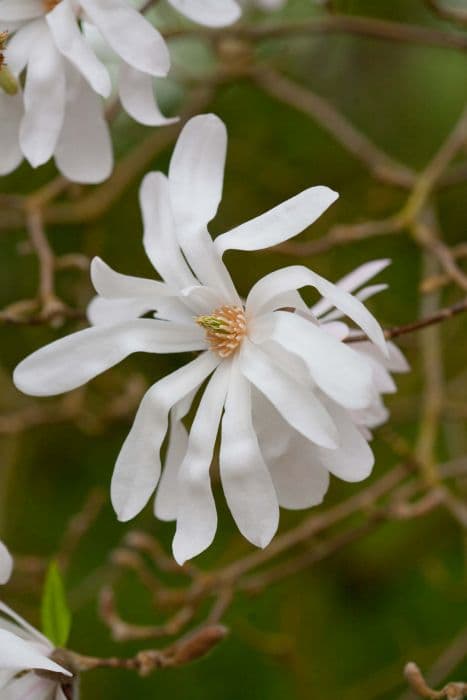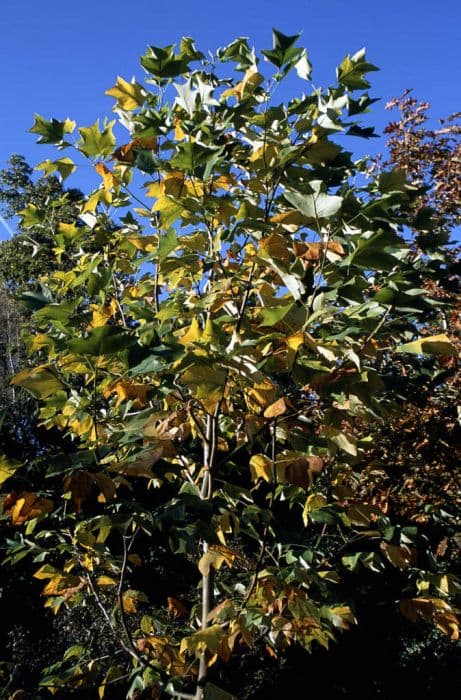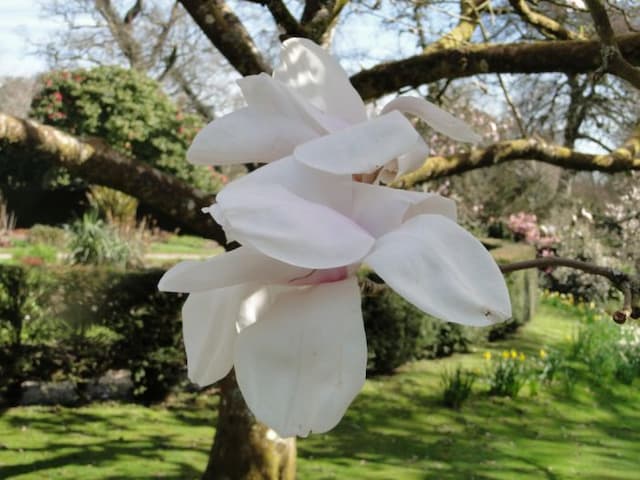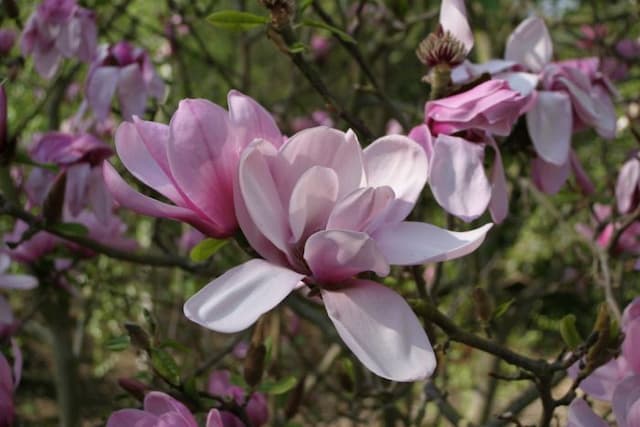Star Magnolia Magnolia stellata 'Rosea'

ABOUT
The Magnolia stellata 'Rosea', commonly known as the pink star magnolia, is a striking flowering deciduous shrub that is cherished for its beautiful, early spring blossoms. The flowers are the most distinctive feature of the plant; they are star-shaped with numerous narrow petals, giving the plant its starry appearance. The petals are soft pink, which adds a gentle splash of color to the landscape. These blooms are not only beautifully shaped but also have a delicate, sweet fragrance that can be enjoyed when standing close to the plant. The leaves of the pink star magnolia are notably attractive as well. They emerge shortly after the flowers, have an oval shape, and are a fresh, bright green color. The foliage provides a lovely backdrop to the pink blooms during the flowering season and continues to add visual interest throughout the summer months. During the fall, the leaves may turn yellow or brown before dropping, as is typical with deciduous shrubs. The plant also has a smooth, gray bark that provides winter interest after the leaves have fallen. Although the size has been excluded from this description, it's important to note that the plant's growth habit is typically rounded and bushy, giving it a balanced and attractive shape in the garden. The pink star magnolia is an ornamental shrub that adds a touch of elegance and enchantment to any garden with its stunning floral display and alluring fragrance.
About this plant
 Names
NamesFamily
Magnoliaceae
Synonyms
Pink Star Magnolia, Rosea Star Magnolia
Common names
Magnolia kobus var. stellata 'Rosea', Magnolia stellata f. rosea.
 Toxicity
ToxicityTo humans
The Star Magnolia is not considered toxic to humans. It does not typically cause poisoning or adverse reactions if ingested. However, it's always a good practice to avoid eating parts of ornamental plants due to potential individual allergic reactions or the possibility of stomach upset.
To pets
The Star Magnolia is not known to be toxic to pets. It is not associated with causing poisoning in animals such as cats and dogs if they ingest parts of the plant. Nonetheless, it's advisable to prevent pets from consuming plant material to avoid potential gastrointestinal discomfort.
 Characteristics
CharacteristicsLife cycle
Perennials
Foliage type
Deciduous
Color of leaves
Green
Flower color
Pink
Height
15 feet (4.6 meters)
Spread
10 feet (3 meters)
Plant type
Shrub
Hardiness zones
4
Native area
Japan
Benefits
 General Benefits
General Benefits- Early spring bloom: Magnolia stellata 'Rosea', commonly known as Star Magnolia, produces flowers early in spring, offering a splash of color after winter.
- Ornamental value: Its distinctive pink flowers have a high ornamental value for landscaping and garden design.
- Attracts pollinators: The blossoms attract bees and other pollinating insects, which are essential for the health of the garden and the environment.
- Compact size: It is a small, multi-stemmed shrub, which makes it suitable for smaller gardens or limited spaces.
- Low maintenance: Star Magnolia generally requires minimal pruning and upkeep once established.
- Adaptability: It is relatively adaptable to a variety of soil types, though it prefers well-drained, slightly acidic soil.
- Deciduous nature: As a deciduous plant, it contributes to seasonal interest in the garden.
- Drought tolerance: Once established, it exhibits some drought tolerance, reducing the need for frequent watering.
 Medical Properties
Medical PropertiesThis plant is not used for medical purposes.
 Air-purifying Qualities
Air-purifying QualitiesThis plant is not specifically known for air purifying qualities.
 Other Uses
Other Uses- Photography and Painting Subject: Magnolia stellata 'Rosea', commonly known as Pink Star Magnolia, often serves as an inspiring subject for photographers and artists due to its stunning, delicate pink blooms.
- Floral Arrangements: The branches of Pink Star Magnolia can be cut and used in floral arrangements, especially for spring-themed decorations or weddings, adding a touch of natural elegance.
- Culinary Garnishing: The petals of Pink Star Magnolia may be used for garnishing desserts and dishes in high-end culinary presentations for an upscale, aesthetic touch.
- Symbolic Gifts: In horticultural gift-giving, Pink Star Magnolia plants or seeds can symbolize dignity and splendid beauty, making them suitable as gifts for significant occasions.
- Educational Tool: With its distinct features, the Pink Star Magnolia provides an excellent educational example for botany students studying flower structures and variations among species.
- Wedding Decor: Because of their romantic appearance, Pink Star Magnolia blossoms are sometimes incorporated into wedding venue decor, particularly for spring ceremonies.
- Botanic Illustration: The distinctive shape and color of Pink Star Magnolia flowers make them a favorite among botanical illustrators and hobbyists practicing their plant drawing skills.
- Perfumery Inspiration: Although not commonly extracted for its scent, the fragrance of Pink Star Magnolia blooms can inspire unique scents in artisan and homemade perfumes.
- Feng Shui: Some practitioners may use the Pink Star Magnolia in their garden arrangements as it is believed to bring balance and positive energy according to Feng Shui principles.
- Fabric Patterns: The design of Pink Star Magnolia's petals can inspire patterns for textiles, including clothing, curtains, and upholstery, lending a natural motif to fabric designs.
Interesting Facts
 Feng Shui
Feng ShuiThe Star Magnolia is not used in Feng Shui practice.
 Zodiac Sign Compitability
Zodiac Sign CompitabilityThe Star Magnolia is not used in astrology practice.
 Plant Symbolism
Plant Symbolism- Nobility: Magnolias are often associated with nobility due to their graceful and impressive appearance.
- Purity: The immaculate beauty of the magnolia blossom is symbolic of purity and innocence.
- Dignity: Magnolia trees carry an air of dignity and poise, representing respect and self-esteem.
- Perseverance: As an early bloomer, magnolias symbolize endurance and perseverance through tough conditions.
- Feminine beauty: The delicate petals of the 'Rosea' variety can be seen as a representation of soft, feminine beauty.
- Love of nature: The natural elegance of the magnolia tree signifies a love for and connection to the natural world.
 Water
WaterTo properly water a Star Magnolia, it is important to keep the soil consistently moist but not waterlogged. During the growing season, water the plant deeply once a week, providing about 1 to 1.5 gallons per watering session. Adjust the frequency during hot or dry periods to possibly twice a week. In winter, reduce watering to every two weeks or less, depending on the climate and weather conditions. Ensure that the plant has adequate drainage to prevent root rot. Always check the top inch of soil for dryness before watering.
 Light
LightStar Magnolias thrive in areas that receive full sun to partial shade. The ideal spot for them is where they can get at least four hours of direct sunlight daily but are protected from harsh afternoon sun, especially in hotter climates. A location with bright, indirect light for the remainder of the day will help promote abundant flowering.
 Temperature
TemperatureThe Star Magnolia is hardy and can withstand winter temperatures as low as 20°F, while summer temperatures above 90°F may require additional watering to keep the plant healthy. The ideal temperature range for this magnolia is between 60°F to 75°F for optimal growth and flowering. They can survive short periods outside these ranges but prolonged exposure can be stressful to the plant.
 Pruning
PruningPrune Star Magnolias to shape the tree, remove any dead or damaged branches, and promote healthy growth. The best time to prune is soon after the tree has finished flowering in late spring or early summer. Prune sparingly, as this plant does not require heavy pruning. Remove only the necessary branches to maintain a pleasing shape and remove any crossed branches to prevent wounds.
 Cleaning
CleaningAs needed
 Soil
SoilStar Magnolia prefers well-drained, acidic to neutral soil with pH 5.5 to 7. A mix of loam, compost, and coarse sand is ideal for healthy growth.
 Repotting
RepottingStar Magnolias are typically not repotted as they are outdoor plants, but young trees should be planted in their permanent location, where they can grow without the need for repotting.
 Humidity & Misting
Humidity & MistingStar Magnolia does not have specific humidity requirements, as it adapts well to the ambient outdoor humidity in the environment where it naturally thrives.
 Suitable locations
Suitable locationsIndoor
Not suitable for indoor growing; Star Magnolia requires outdoor conditions.
Outdoor
Plant in sun to part shade, shelter from strong winds, and mulch.
Hardiness zone
4-8 USDA
 Life cycle
Life cycleThe Star Magnolia 'Rosea' begins its life cycle as a seed, which after undergoing stratification, germinates in the spring. Seedlings rapidly develop a root system and foliage, entering a juvenile vegetative stage where they focus on growth rather than reproduction. As they mature over several years, they reach an adult vegetative stage characterized by the development of woody stems and the capacity to produce the characteristic pink-tinged, star-shaped flowers in early spring before the leaves emerge. After pollination, typically by insects, the flowers develop into aggregate fruit displaying follicles that release the seeds. Once mature, the plant enters a repetitive flowering and seeding phase, which can last for decades. The Star Magnolia 'Rosea' eventually reaches senescence, during which growth slows, and it becomes less prolific until it eventually dies.
 Propogation
PropogationPropogation time
Spring
The Star Magnolia can be propagated most effectively through softwood cuttings, which is the most popular method among gardeners. This technique is best performed in late spring to early summer, when the plant's new growth is still flexible but mature enough to withstand cutting and replanting. You take a cutting of about 4 inches (approximately 10 centimeters), making sure there are at least 2-3 nodes present. Remove the leaves from the lower half of the cutting to expose the nodes where roots will emerge, dip the cut end in rooting hormone powder to encourage root growth, and plant the cutting in a pot with well-draining soil. The pot should then be placed in a warm, bright spot but out of direct sunlight, and the soil should be kept moist but not soggy until roots develop. This process usually takes a few weeks to a couple of months, after which the rooted cuttings can be gradually acclimatized to outdoor conditions before planting in their permanent location.









![Magnolia [Felix Jury]](/_next/image?url=https%3A%2F%2Fplants-admin.emdemapps.com%2Fimages%2Fplants%2F%2Fimages%2F604b61a0b23b7.png&w=640&q=75)